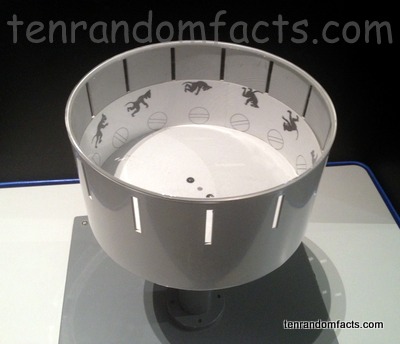As hard as you try, your eyes cannot break free from the zoetrope illusion.
- A zoetrope is an invention that creates the appearance of a moving picture, even when the images used are still, and while they were popular in the mid to late 1800s, they were ultimately replaced by film projectors.
- ‘Zoetrope’ comes from the Greek words ‘zoe’ and ‘trope’, which mean ‘life’ and ‘turn’ respectively, and when combined are said to have the meaning ‘wheel of life’.
- Zoetropes are of a cylindrical shape with vertical slits placed systematically around the side of the cylinder, above a sequence of images that are found inside.
- If one peers through the slits on the sides of a zoetrope while the cylinder spins, the images inside appear to be animated.
- An Iranian bowl with images of a goat leaping to a tree to forage, dating back to 4000 to 3000 BC, is the oldest known predecessor of a zoetrope.
- Zoetropes work due to an illusion, known as ‘persistence of vision’, as the brain sees images flashing before one’s eyes, that move at less than a tenth of a second, as continuous, and while ever there is enough speed, and an interruption in the light by a slot or black line or similar, the pictures will seem to be animated, and without the line or slot, the images will blur.
- The modern zoetrope debuted in the 1830s, and was invented by William George Horner, an English mathematician; however slits were placed between images and he called the invention a ‘dædaleum’.
- In the 1860s, zoetropes were made differently to the original dædaleums, which had slits placed slightly above the images, rather than between them, which were more practical as they allowed for the image strips to be easily replaceable while still functioning properly.
- As of 2015, the largest zoetrope ever built, known as the ‘BRAVIA-drome’, spread 10 metres (33 feet) in diameter, and was made for Sony in 2008, in Italy, Europe.
- A zoetrope is likely based on the phenakistoscope that was designed before it, which was effectively a flat disc with images and slits, spun on a stick and viewed in front of a mirror, so that the viewer could peer through a slit at the reflection of the ‘moving’ images in the mirror.
Bibliography:
Hayes R, Pre-cinema Animation Devices, 2011, Random Motion, http://www.randommotion.com/html/zoe.html
Zoetrope, 2016, Wikipedia, https://en.wikipedia.org/wiki/Zoetrope
Zoetrope History, n.d, Zoetrope & Praxinoscope, http://zoetrope.org/zoetrope-history






